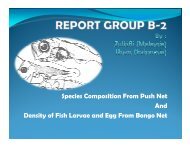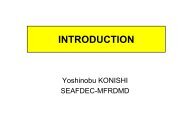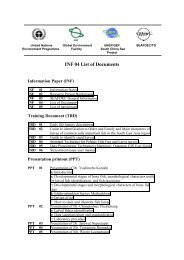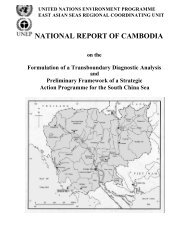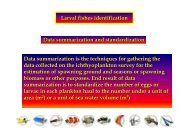Procedures for Laboratory-Based Processing of Fish Egg and ...
Procedures for Laboratory-Based Processing of Fish Egg and ...
Procedures for Laboratory-Based Processing of Fish Egg and ...
Create successful ePaper yourself
Turn your PDF publications into a flip-book with our unique Google optimized e-Paper software.
Larval fishes identification<br />
<strong>Laboratory</strong> procedure<br />
Zooplankton biomass<br />
measurement<br />
(Displacement or<br />
Settled volume)<br />
Sorting<br />
<strong>Fish</strong> eggs<br />
<strong>Fish</strong> larvae<br />
Identify<br />
St<strong>and</strong>ardization<br />
Size<br />
Measurement<br />
Count
Sorting<br />
1. Draining the samples through a h<strong>and</strong> net (mesh size same as plankton net). Use two jugs when<br />
draining<br />
2. Return the fixatives into an original sampling jar<br />
3. Washing the specimens with fresh water<br />
4. Retain specimens in a jug with fresh water<br />
5. Stir the solution s<strong>of</strong>tly with glass rod<br />
6. Pour a small amount <strong>of</strong> samples into a petri-dish.<br />
7. Use tiny thin stainless steel <strong>for</strong>ceps to pick up fish eggs <strong>and</strong> larvae l<br />
from the petri-dish under<br />
dissecting microscope at a magnification <strong>of</strong> about 10 times (10x ocular, 1x objective) <strong>and</strong> place in a<br />
label petri-dish. Precaution must be taken to prevent deterioration <strong>of</strong> specimens when picking.<br />
Count the number <strong>of</strong> fish eggs <strong>and</strong> larvae by using counter to record the number while you are<br />
removing them from the sample. (During sorting you may preliminary ry identify your specimens<br />
<strong>and</strong> count <strong>and</strong> record the number)<br />
8. Keep doing 6 <strong>and</strong> 7 a little bit by bit until no more sample left<br />
9. Store fish eggs <strong>and</strong> larvae into separate labeled vial. The preservative rvative fluid in the vial is 70%<br />
ethanol. Place label in each vial, the in<strong>for</strong>mation on label including uding sampling date, station number,<br />
sampling site, sampling method (oblique or horizontal or vertical l tow), plankton net type. Use<br />
pencil <strong>for</strong> labeling<br />
10. In case that you cannot finish sorting by one day. Please put back the unsorted plankton into 5%<br />
buffer <strong>for</strong>malin. Then continue sorting with the above process on the next day<br />
11. After sorting, the remaining plankton will be replaced in the original o<br />
sampling jar <strong>for</strong> processing<br />
later.<br />
12. The total number <strong>of</strong> fish eggs <strong>and</strong> larvae removed from the sample are recorded on the plankton<br />
work sheet







